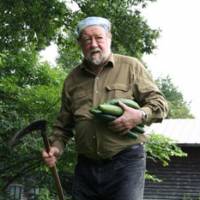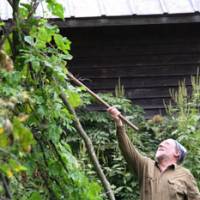Copying a Canadian friend, during spring for the last two years I have built tepee frames, not conventional trellises, for my cucumbers to trail around as they grow.
This year, I built a frame high and wide enough for me to stand up inside, planted young cucumber vines around the base of its poles, and piled well-rotted grass and weed cuttings in the middle to help feed these fast-growing annuals. During the summer, I kept adding to the pile of compost in the middle and the cucumber plants flourished.
I have a great liking for cucumbers of all kinds, but perhaps my favorites are the small, gherkin-like ones that my dear friend Mr. Matsuki — chief forester of our Afan Woodland Trust up here in the Nagano hills — grows from seeds whose provenance goes back to his grandfather.
These are a rather "primitive" variety of the fruit, with small seeds and a strong cucumber smell that I enjoy. He gives me enough to pickle and bottle for my winter larder, and every day through the hot summer he takes a plastic bag of them, with a handful of salt thrown in and mixed up, to his hut in the woods. There, he places the bag in a pool of spring water to stay cool, and we take out a couple to munch on whenever we have breaks between doing woodland jobs — and what a marvelous pick-me-up they are!
In my own backyard, I grow larger cucumbers from young plants purchased at our local gardening supplier, pretty well the same as everybody else. I like the large cucumbers too, sliced with a little salt, or more thickly sliced and put into a container with a large dash of balsamic vinegar, some sesame oil and soy sauce. The cucumbers lightly pickle themselves in their own water, drawn out by the salt in the soy sauce. If you leave the liquid in the jar for a few days, adding to the cucumber slices as you eat them, it makes a very refreshing, savory drink. I also like cucumbers with yoghurt, or cooked in a spicy Chinese way.
This was a very busy summer for me, and I'm afraid my own vegetable patch largely succumbed to weeds. The cucumber vines, though, carried on regardless and grew up the tepee until their heads were high above the mugwort, dock and grasses, which I would cut back when I had some spare time and toss onto the compost pile inside the tepee. This pile got trodden down each time I went in to grab some cucumbers (and the few tomatoes and hot peppers I'd also planted around the poles).
I confess to being spoiled by Mr. Matsuki, who, beside all the work he does in the woods up here outside Kurohime, also grows fine vegetables, potatoes and such on a little patch of farmland I own. He shares the produce with me as I need it. (We had a lot of our sweet potatoes and watermelons destroyed by wild boars this year, but that's another story.)
Looking up information on the Internet and in my collection of gardening books, I found that the cucumber — Cucumis savis — is a member of the gourd family native to southern Asia, and that there are about 100 varieties grown around the world. Long ago, it seems, they were taken to India, from where they spread throughout Asia, then westward to ancient Greece, Rome and on throughout Europe, from where they were taken to the Americas, Australia and so on.
Cucumbers are rich in vitamins and minerals, with lots of fiber, while from my grandmother I learned that, applied externally, they are good for relieving sunburn and even other minor burns. I hadn't been here very long before I also discovered the delights of the small, crunchy Japanese cucumbers sliced and rolled up with rice and nori — kappa maki (kappa rolls) as they are known, referring to the legendary kappa water creatures that are supposed to be extremely fond of cucumbers.
But back to my cucumber tepee — which produced far more fine specimens throughout July, August and most of September than even I could eat or give away.
After that I started traveling a lot and once again neglected my plot — neglect that was a boon to a whole covey of pheasants that grew up in my backyard jungle.
Then in mid-October I returned from Britain and I wondered how the pheasants were doing. Taking a look out, I saw that the cucumber vines had spread out over the ground from the bottom of the tepee in a radius of several yards. And, to my surprise, I noted that many of them had new yellow flowers. They were definitely cucumber vines, and looked no different from the ones by then dying back on the tepee.
Still no wiser about the pheasants, I went away again — lecturing in Kansai, Okinawa and Tohoku. When I next looked at my backyard, in the first week of November, I found lots of large, green, smooth-skinned fruits on the ground attached to those thorny cucumber vines.
They were as big as rugby balls, and looked like melons on the outside. However, there have been no melons planted in my plot, not even watermelons, and these things were definitely growing off the same vines from the tepee.
I took one inside and cut it open. It had large seeds that were sweet to the taste. The smell of the white flesh was faintly that of cucumber, as was the taste. The skin, though, was completely smooth and too hard even to cook. I tried them sliced, diced and slightly pickled in good old balsamic vinegar, sesame oil and soy sauce. They were excellent like that, and so I diced more from the same plant to make kimchi, which was also very good. The rest I cooked as I would daikon radish. All good.
One of these mega-cucumbers gives enough food to serve at least 20 people, and I've got a couple of dozen of them sitting out on the ground, with frost now on the mountain and autumn leaves falling.
I shall have to see how they last. If they start going yellow and soft I'll dump them in the compost, but if they stay green and firm for a while longer I will try to get friends and neighbors to try them out.
For several days I thought I had stumbled upon a new mutant strain of cucumber. Then, yesterday, Mr. Matsuki popped round to see me and I took him out into the backyard.
When he first set eyes on the green things scattered around like rugby balls on a badly kept pitch, he said: "That's strange. Never seen that before." Then he looked at the vines and saw that the ones that had spread out from the tepee frame had grown roots.
"Huh!" he snorted. "Grafted, that's what. These things came off the original cutting."
It seems that cucumbers are commonly grafted onto root stock from pumpkins, watermelons, white gourds, bottle gourds and such — plants that are more resistant to disease and pests. So my green rugby balls were actually a cucumber-something cross. Ah, well, I must admit that I'm a little crestfallen at having the mystery so simply solved — but they still taste pretty good and there's lots of them!























With your current subscription plan you can comment on stories. However, before writing your first comment, please create a display name in the Profile section of your subscriber account page.